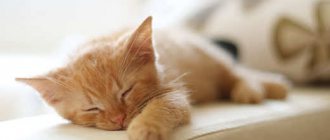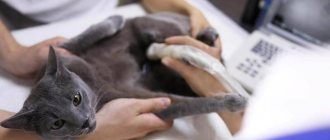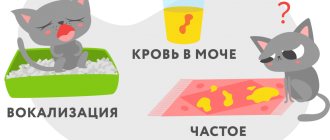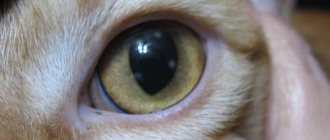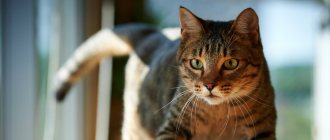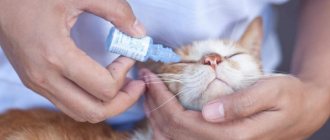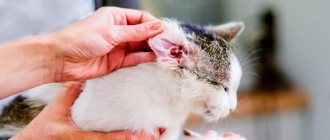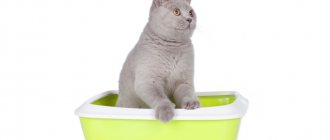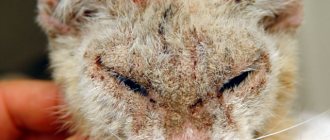Reasons and typology
Difficulty or cessation of the passage of food can be caused by a violation of motor function, in particular paralysis, or mechanical function of the intestines.
Mechanical intestinal obstruction in cats can be caused by a variety of factors:
- blockage of the intestines by a foreign object is the most common cause, since cats are prone to swallowing small household items (threads, needles, rags, toys, their own fur, etc.);
- neoplasms in the abdominal cavity, or directly in the intestinal wall itself;
- volvulus or torsion of the intestine;
- intussusception (that is, a condition in which one part of the intestine turns inside another part);
- hernias;
- abscesses or granulomas;
- adhesive disease;
- congenital anomalies, in particular intestinal diverticulum.
The essence of the problem
In the stomach of any animal there is a continuous production of large amounts of digestive juices. This process is absolutely independent of food intake and occurs even during prolonged fasting. The main function of the intestines is to push the contents of the stomach towards the anus. As they move through the organ, these digestive juices are absorbed back through the intestinal walls, but along with nutrients, carrying out a constant circulation of large amounts of vital fluid.
In case of intestinal pathology, namely, obstruction of the organ, regardless of the reasons that caused it, this turnover is disrupted: gastric juice is produced in the same volume, but it can no longer be absorbed along with the food being promoted.
Symptoms of intestinal obstruction in cats
With partial obstruction, only part of the intestinal contents penetrates through the obstruction, and with complete obstruction, the movement of feed masses stops. Therefore, one of the symptoms is a small amount of feces or their complete absence. In both cases, in the area of the intestine where the blockage occurred, blood circulation is disrupted, which can lead to necrosis, that is, death of part of the intestine. Complete obstruction is characterized by severe clinical manifestations such as sudden onset of vomiting, depression, anorexia, abdominal pain and collapse. This condition is life-threatening for the animal and urgent surgical intervention is required.
The general condition of the cat depends on the degree of obstruction (low, medium, high), the size of the foreign body and the duration of the disease.
The following are the main symptoms of intestinal obstruction in cats:
- decreased appetite, sometimes reaching the point of complete refusal of food;
- periodic vomiting that occurs in most cases;
- reduction in the amount of feces or their complete absence;
- pain and increased abdominal volume;
- deterioration of general condition.
Dehydration of the body is also noted as a result of impaired water absorption and an imbalance of intestinal microflora. With prolonged fasting, exhaustion may occur, and as a result, the overall body temperature decreases (less than 37? C), general weakness occurs, and shortness of breath may occur. If help is not provided to a cat in this condition, this may result in the death of the animal.
Therefore, if the above clinical signs occur, you should immediately contact a qualified veterinarian at a veterinary clinic.
It should also be understood that each case is individual, and not all cats have pronounced symptoms. In some animals, intestinal obstruction may manifest itself with only a few of the signs listed above, so you should be attentive to your pets and pay special attention to even subtle changes in their condition.
First signs and general symptoms
The owner needs to pay attention and find out the cause of changes in the pet’s behavior in order to deal with the pathology as quickly as possible. The key symptoms of blockage are the absence of bowel movements, that is, constipation, and vomiting.
How can you tell if your cat has an intestinal obstruction?
External symptoms of intestinal obstruction in cats can easily be confused with the clinical picture of a viral disease. Such similarity can be dangerous for determining the diagnosis, so you should not make decisions about the use of medications on your own. If you notice the appearance of several signs at once, you need to contact a specialist:
- Vomiting, which is associated with the accumulation of fluid in the stomach. Digested food gets stuck in the passages, mixing with gastric juice. Overcrowding of the digestive tract leads to repeated vomiting and dehydration. The pet tries to drink, but it only gets worse.
- Refusal to eat. The animal wants to eat, but does not even accept its favorite treats, because it experiences pain in the abdominal cavity.
- Abdominal enlargement. This occurs due to the accumulation of excrement in the intestine. The walls of the organ stretch and the abdomen enlarges. This causes great discomfort and severe pain.
- The formation of gases is associated with the growth of pathogenic microorganisms inside the body. This becomes the result of the accumulation of decay products and subsequent intoxication.
- Repeated attempts to defecate without success. The pet often goes to the toilet, trying to get rid of discomfort. Unfortunately, attempts do not bring a positive result, but only increase the pain inside the abdomen.
One or more signs that appear in a pet are considered serious signals to contact a veterinarian. It is likely that an independent attempt to alleviate the pet’s condition will lead to deterioration in health. Treatment of intestinal obstruction in cats is based on symptoms.
What should the owner do in case of suspicion?
Stagnation in the large or small intestine can cause organ rupture. This almost immediately leads to the death of the patient. You should not use laxatives or give cleansing enemas - they increase the risk of rupture significantly. Antiemetics can reduce symptoms, but will not remove the root cause of the pathology. The only correct decision that the owner can make is a prompt visit to the veterinary clinic. It is advisable not to postpone the visit to a certain day, but to go to the veterinary hospital immediately after detecting alarming symptoms.
Diagnosis of intestinal obstruction in cats
At the clinic, you should tell the doctor in detail about all the changes you notice in the cat’s condition. The specialist will carefully examine the animal; it may be necessary to take blood and urine tests to assess the condition at the time of treatment and rule out poisoning and infectious complications. Taking into account the general condition of the cat, the doctor prescribes a treatment regimen.
Most likely, a plain radiograph of the animal's abdominal cavity will be required. Intestinal ultrasound in this situation is not very informative, but sometimes you can see indirect signs of a foreign object, as well as evaluate peristalsis.
Fig.1. Wire in a cat's rectum
Plain radiography often does not provide enough information to make a diagnosis (unless the animal has a radiopaque foreign body), but it helps determine what part of the gastrointestinal tract is affected.
It should be remembered that not all objects can be seen on an x-ray. Needles, paper clips, stones, glass, and so on are radiopaque. But plastic, rubber, threads and other similar objects can only be detected with the help of an X-ray contrast agent. In this case, the cat is fed a contrast agent and a series of photographs are taken to track its passage through the digestive tract at 15 minutes, 30 minutes, 2 hours, 6 hours after the administration of the contrast agent, and then at the discretion of the veterinarian.
Rice. 2. Silk ribbon in the small intestine of a cat.
But palpation and radiography of the abdominal cavity usually make it possible to make a presumptive diagnosis and provide grounds for diagnostic surgery. This can be diagnostic laparotomy, laparoscopy, fibrogastroduodenoscopy (FGDS), during these studies the doctor conducts a more detailed examination of the organs of the digestive system.
Diagnosis and treatment
The doctor begins to draw up a clinical picture of the disease by asking the owner about the animal’s diet and behavior. The owner should remember in advance everything that preceded the symptoms. This will speed up the diagnosis.
Veterinarian actions
During the initial examination, the veterinarian will palpate the patient's abdomen. A dull sound coming from the abdominal cavity when tapping becomes the first sign of illness. Subsequent steps to clarify the diagnosis include the following studies:
- radiography;
- colonoscopy;
- Ultrasound;
- irrigoscopy using a contrast agent.
The next stage is the collection of tests. Blood and urine tests can help assess the level of inflammation. After this, treatment for intestinal obstruction in the cat is prescribed, which may consist of drug therapy or surgery.
To eliminate secondary symptoms, the pet is given drips with a nutrient solution, pain relievers, and anti-inflammatory drugs are administered. In case of severe dehydration, water-salt solutions are instilled into the cat.
If the obstruction is treated without surgery, the doctor prescribes microenemas, as well as drugs that remove the intestinal plug.
The operation is performed under general anesthesia, after which the furry patient remains in the hospital for some time. After the pet's condition has stabilized, it is handed over to the owner.
Postoperative period
The patient should not be given food or water for 24 hours. The first time he is fed only after two days, preferably with pureed food. The cat should be provided with complete rest so that the stitches do not come apart during movements. In a veterinary hospital, the patient is injected with saline solution - it helps maintain optimal fluid levels in the pet’s body. This prevents the development of dehydration and neutralizes the effect of toxic substances on the body.
Within a few days after surgery, the cat is prescribed a course of antibiotics - they are administered in the form of injections. Such drugs prevent the spread of inflammation caused by pathogenic microflora.
Diet and feeding recommendations
Nutrition is very important to restore the health of a pet. In addition to medicines, food must contain all the elements necessary for the body. During this time, only dietary products are allowed. The best way to restore digestion is natural food - such products will provide your pet with essential fiber and healthy vitamins.
Portions should be small, and meals should be fractional. This will avoid overloading the digestive system and will ensure the free passage of digested food. Veterinarians recommend giving preference to fermented milk products with zero fat content and boiled lean meat. A few days after the operation, you can give oatmeal porridge cooked in broth.
Treatment of intestinal obstruction in cats
As a result of establishing the cause, further actions can be judged: either conservative therapeutic treatment of the sick animal is carried out, or emergency surgery is performed to eliminate the cause of blockage of the intestinal lumen (if a foreign body, hernia, tumor, etc. is detected).
Surgery is also necessary if symptoms persist or worsen, or if signs of peritonitis are noted.
In all cases, special attention should be paid to stabilizing the animal and restoring fluid and electrolyte balance after surgery.
Caring for a sick cat
After initial treatment, symptoms and progress should be monitored. It is important to replace fluid loss (for example, due to excessive vomiting or diarrhea) to avoid dehydration.
Physical activity should be limited and the diet should consist of bland foods for one to two days, followed by a gradual return to normal eating. Please note that it should not be given orally until the obstruction has been removed and vomiting has stopped.
What to do if you suspect intestinal obstruction in a cat
If you notice symptoms of intestinal obstruction in your pet or suspect that the cat may have swallowed any foreign objects, immediately seek help from a veterinary clinic!
Do not force feed or water your cat, as this may cause vomiting. You should not give antiemetic drugs that do not have a therapeutic effect. Laxatives and drugs that enhance intestinal motility may in some cases be contraindicated, since their action can lead to intestinal rupture.
Clinical signs may not always be clear, so you need to contact a qualified specialist at the clinic as soon as possible, since the clinic has all the necessary equipment for a speedy diagnosis.
Which breeds are more susceptible
Ileus can occur in any cat, regardless of age or gender. Representatives of long-haired breeds, for example, Persians, Siberians, Maine Coons, are most susceptible to this phenomenon. Numerous hair that enters the stomach during licking forms trichobezoars - dense hairballs. They are the most common cause of intestinal obstruction.
Clinical case of treatment of intestinal obstruction in a cat
The cat Izyum was admitted to the Pride Veterinary Center with complaints of repeated vomiting with blood and refusal to feed for three days.
During an examination by veterinary therapist A. M. Vasilyeva, a thread was discovered under the tongue. After X-ray diagnostics with contrast, a diagnosis of intestinal obstruction was made. Surgeon A.K. Mamedkuliev performed surgery and the thread was completely removed.
At the moment, Izyum’s condition is excellent, he is undergoing treatment at home.
Main symptoms
At the initial stage, obstruction (ileus) practically does not appear. Signs such as nausea, constipation, and bloating should alert the owner.
As the disease progresses, the cat stops showing interest in food and does not drink. This is due to the fact that the stomach does not empty and becomes larger due to undigested food. Nausea progresses to vomiting, attacks of which occur every 15-20 minutes. Vomit sometimes contains stool particles.
There is no chair. At the onset of the disease or in case of partial obstruction, small passages of feces formed before the intestinal blockage are possible.
Due to the fact that gases do not escape, the cat's stomach becomes bloated. The pet constantly licks it, feeling severe pain. Fluffy doesn't allow you to touch his belly.
During palpation, you can feel the tension and hardness of the abdominal cavity; sometimes a foreign body that the cat has swallowed can be felt.
Prevention of obstruction
To prevent this dangerous condition, the owner must:
- provide your pet with a balanced diet, trying not to feed him only dry food;
- ensure that he always has clean and fresh water;
- do not allow the cat to play with small objects that it may accidentally swallow;
- Constantly comb the animal, especially during the period when it sheds heavily.
By following these simple recommendations, you can reduce the possibility of obstruction to a minimum.
Postoperative care
Postoperative treatment for cats is as follows:
- After abdominal surgery, it is necessary to ensure proper care of the postoperative suture and put a collar on the cat to prevent licking.
- A complete fasting diet is required for 12–24 hours.
- You will probably need to administer saline solutions with vitamins, cardiac and antispasmodics.
- Sometimes, after recovering from anesthesia, an enema with Vaseline oil is prescribed when there is accumulation of feces in the thick section.
- After 24 hours, you can give special food, diluted to a liquid paste, 1 teaspoon every two hours. As a rule, after surgery, cats' appetite is quickly restored. and the owners, to celebrate, begin to increase the portion. You can't, control yourself! The cat’s intestines are not yet ready for active work, take care of the surgeons’ work!
Only after the stitches are removed, appetite is restored, and regular, formed feces appear, you can relax a little: everything is behind you.
Unfortunately, when it comes to laparotomy in a kitten, not everything is so simple, the work ahead is exquisite, this can be said about the operation itself and about the postoperative period, the selection of anesthesia drug, special surgical material, and dosage of medications are very important.
First aid
If you find that an animal has digestive problems, give it first aid. Limit your cat's food intake completely and give her fresh water regularly. No laxatives, especially saline laxatives, especially bisacodyl and other irritating drugs should not be given to your cat! Vaseline oil is relatively safe, but you should consult your doctor before using it. Cats do not like oil, and you will have to pour quite a lot of it, so make sure you have an assistant and good support for the animal. Unfortunately, petroleum jelly is effective only in mild cases when the stool is still soft. If your cat vomits after taking the oil, go to the doctor immediately!

